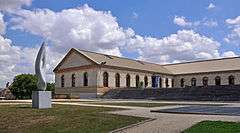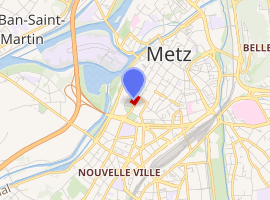Arsenal de Metz
The Arsenal Concert Hall is a cultural venue dedicated specially to classical and art music and located near the Esplanade garden in Metz, capital of the Lorraine region, France. The Arsenal is home to the Orchestre National de Lorraine and almost 200 events are spread over the season period between September and June. The Arsenal has gained wide recognition as one of the most beautiful concert halls in the world.[1]
| The Arsenal | |
|---|---|
Arsenal Ney | |
 The Arsenal on the Esplanade garden | |

| |
| General information | |
| Type | Music venue |
| Architectural style | Military architecture; Post-modern |
| Location | Avenue Ney, Metz, France, Europe |
| Construction started | 1859 |
| Completed | 1864 |
| Inaugurated | 1989 |
| Owner | Municipality of Metz |
| Technical details | |
| Floor area | 10,000 m2 |
| Design and construction | |
| Architect | Ricardo Bofill |
The Arsenal is part of a cultural complex along with the chapel of the Knight Templars, from the 13th century, and ancient basilica of Saint-Pierre-aux-Nonnains, a Roman basilica of the 4th century, refurbished as showroom and concert hall for the Gregorian chant, respectively.
Architecture and urbanization
In 1978, the municipality of Metz decided to launch a project of a concert hall, and the site reserved was the citadel, on which is situated the ancient Arsenal Ney. Built from 1859 under Napoleon III, the Arsenal Ney was a store for weapons and ammunition. It preserved this function until the end of World War II . The realization of the concert hall was the subject of an international competition, started in 1983. In 1985, the project was awarded to the Spanish architect Ricardo Bofill. The work began in May 1987 and the inauguration took place in February 1989 with a performance of Russian cellist Mstislav Rostropovich, who stated that the venue was "an instrument of music on its own."
The arsenal was originally arranged as a quadrangle. Architect Ricardo Bofill removed one of its sides and opened a vast terrace in the rear which established a meeting area, also for both other ancient edifices, Saint-Pierre-aux-Nonnains and the chapel of the Knight Templars. Under the square created between the aisles of the building, the concert hall is located, three-quarters buried. The regular lines of the arsenal were preserved. Windows open in a classic frame in Jaumont's stone put on by a Roman arch decorated with a stony key. Facades are plated by an Italian honey-colour stone, joints are in brass, and roofs are in lacquered bronze-like metal. The warm colors of the interior decoration with wooden beech and sycamore classic pilasters were chosen to evoke the furniture of marquetry or ancient musical instruments. For the tenth anniversary of the Arsenal's inauguration, the terrace was adorned with a sculpture, La Sentinaile, which is an artwork of Antoine Poncet.
Size and acoustic
The facility consists of a concert hall with 1,500 places (the Grande Salle), a room with 350 places (the Esplanade hall), two reception rooms (Governor and Orangerie halls), an exhibition gallery, a shop selling art, and a restaurant. The dimensions are placed next to those of Musikverein of Vienna and the volume of the room is about 13,600 cubic meter. Ceilings were established by boxes in staff finalized by the acousticians. Since its inauguration, the Arsenal has gained wide recognition for the quality of its musical acoustics.
Performance and cultural policy
Numerous musicians of repute have performed in the venue, including Yevgeny Svetlanov, Sergiu Celibidache, Lorin Maazel, Evgeny Kissin, William Christie, Philippe Herreweghe, Nikolaus Harnoncourt, Jordi Savall, Philippe Jaroussky, Lang Lang, or Grigory Sokolov. Dances take equally part to the programing and emblematic figures of contemporary dance have performed there, such as Angelin Preljocaj, Sasha Waltz, Merce Cunningham, or Trisha Brown.
The music venue was used in several artistic productions, such as the soundtrack of the film, Farinelli, or the Live At the Arsenal in Metz album of Michel Petrucciani. The concert hall held in 2009 and 2020 the Victoires de la Musique Classique, the annual French award ceremony that recognizes classical musicians.
See also
References
- Classica magazine, Special Issue, September 2010
External links
| Wikimedia Commons has media related to Arsenal de Metz. |